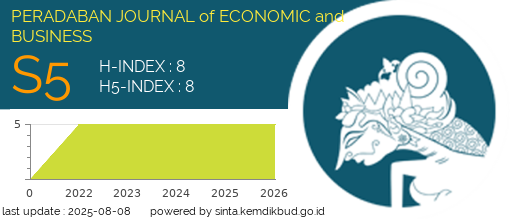The Impact of Innovative Activities on Social Capital and Business Performance
A Study of Young Entrepreneurs in Malang City
DOI:
https://doi.org/10.59001/pjeb.v4i2.519Keywords:
business performance, innovative activities, Malang region, social capital, young entrepreneursAbstract
This study examines the influence of social capital on business performance and the mediating role of innovative activities, with a specific focus on young entrepreneurs in the Greater Malang area. Using a quantitative positivist approach, data were collected through questionnaires from 65 entrepreneurs aged 18–30 who had operated their businesses for more than two years. Structural Equation Modeling (SEM-PLS) with WarpPLS 8.0 was employed for analysis. The results indicate that social capital significantly affects both business performance (β = 0.255; p < 0.001) and innovative activities (β = 0.381; p < 0.001). Innovative activities, in turn, strongly influence business performance (β = 0.551; p < 0.001) and mediate the relationship between social capital and business performance (β = 0.340; p < 0.001). These findings extend the literature by demonstrating how social networks foster innovation as a pathway to performance enhancement in emerging economies. Practically, this research highlights the importance of integrating social capital and innovation into entrepreneurial development strategies, particularly for youth-led businesses.
Penelitian ini mengkaji pengaruh modal sosial terhadap kinerja bisnis serta peran mediasi aktivitas inovatif, dengan fokus pada wirausahawan muda di wilayah Malang Raya. Dengan menggunakan pendekatan kuantitatif-positivistik, data dikumpulkan melalui kuesioner dari 65 wirausahawan berusia 18–30 tahun yang telah menjalankan usahanya lebih dari dua tahun. Analisis data dilakukan dengan Structural Equation Modeling (SEM-PLS) menggunakan WarpPLS 8.0. Hasil penelitian menunjukkan bahwa modal sosial berpengaruh signifikan terhadap kinerja bisnis (β = 0,255; p < 0,001) maupun terhadap aktivitas inovatif (β = 0,381; p < 0,001). Aktivitas inovatif, pada gilirannya, berpengaruh kuat terhadap kinerja bisnis (β = 0,551; p < 0,001) dan memediasi hubungan antara modal sosial dan kinerja bisnis (β = 0,340; p < 0,001). Temuan ini memperluas literatur dengan menunjukkan bagaimana jejaring sosial mendorong inovasi sebagai jalur peningkatan kinerja dalam konteks ekonomi berkembang. Secara praktis, penelitian ini menekankan pentingnya integrasi modal sosial dan inovasi dalam strategi pengembangan kewirausahaan, khususnya bagi usaha yang dipimpin generasi muda.
References
Abazi-Alili, H. (2014). Innovation activities and firm performance: Empirical evidence from transition economies. Faculty of Economics, 1(2), 5–18. https://hdl.handle.net/10419/147455
Ambarwati, A., Purwanti, I., Yosiawati, L., & Budiman, T. A. (2025). The effect of business capital and product innovation on business performance in human resource management. Jurnal Ilmiah Manajemen Kesatuan, 13(1), 129–139. https://doi.org/10.37641/jimkes.v13i1.3051
Ayu Purwati, A. (2021). Social capital, entrepreneurial leadership and SMEs performance: The mediating effect of innovation capability. Jurnal Pendidikan Bisnis dan Manajemen, 7(3), 170–181. http://dx.doi.org/10.17977/um003v7i22021p170
Basri, Y. M., Yasni, H., Azhar-A, A., Hanif, R. A., & Abdurrahman, R. (2021). Human capital, social capital, and innovation capability in performance of village-owned enterprises. Jurnal ASET (Akuntansi Riset), 13(2), 314–330. https://doi.org/10.17509/jaset.v13i2.37763
Boat, A. A., Syvertsen, A. K., & Scales, P. C. (2021). The role of social capital in promoting work readiness among opportunity youth. Children and Youth Services Review, 131, 106270. https//doi.org/10.1016/j.childyouth.2021.106270
Boris, O., Parakhina, V., & Gorlov, S. (2021). Youth entrepreneurship as a factor in solving socio-economic problems in the conditions of the coronavirus pandemic. International Journal of Trade, Economics and Management Studies, 12(2), 44–53. https://doi.org/10.14456/itjemast.2021.256
Creswell, J. W., & Creswell, J. D. (2018). Research design (5th ed.). SAGE Publications.
Djellal, F., & Gallouj, F. (2005). Mapping innovation dynamics in hospitals. Research Policy, 34(6), 817–835. https://doi.org/10.1016/j.respol.2005.04.007
Doan, H. Q., Masciarelli, F., Prencipe, A., & Vu, N. H. (2023). Social capital and firm performance in transition economies. Eurasian Business Review, 13(4), 751–780. https://doi.org/10.1007/s40821-022-00227-y
Doh, S., & Acs, Z. J. (2010). Innovation and social capital: A cross-country investigation. Industry and Innovation, 17(3), 241–262. https://doi.org/10.1080/13662711003790569
Fauziah, S. (2022). Strengthening enterprise performance on youth entrepreneurs through sustainable entrepreneurial orientation and competitive advantage. Jurnal Ekbis, 23(1), 250–260. https://doi.org/10.30736/je.v23i1.1144
Games, D., Ananda, R. P., Sari, D. K., Abbas, A., Komalasari, S. P., & Albatati, B. A. (2024). The role of social capital in innovation and performance: Evidence from women owned SMEs in a matrilineal society. Jurnal Manajemen Universitas Bung Hatta, 19(2), 129–135. https://doi.org/10.37301/jmubh.v19i2.24877
Kafetzopoulos, D., & Psomas, E. (2015). The impact of innovation capability on the performance of manufacturing companies: The Greek case. Journal of Manufacturing Technology Management, 26(1), 104–130. https://doi.org/10.1108/jmtm-12-2012-0117
Lee, W. C., & Law, S. H. (2017). Roles of formal institutions and social capital in innovation activities: A cross-country analysis. Global Economic Review, 46(3), 203–231. https://doi.org/10.1080/1226508x.2017.1292859
Maebane, M. M. (2023). Performance of youth-owned businesses. Corporate Governance and Organizational Behavior Review, 7(1), 64–72. https://doi.org/10.22495/cgobrv7i1p6
Mahadewi, E. P., & Septyanto, D. (2021). Learning to be new youth generation in innovation and creativity with entrepreneurship. International Journal of Educational Research & Social Sciences, 2(6), 1363–1370. https://doi.org/10.51601/ijersc.v2i6.231
Maming, M. H., Mashud, M., & Suaidi, F. (2023). Social capital for young Indonesian entrepreneurs’ development. International Journal of Social Science and Human Research, 6(6), 123–131. https://doi.org/10.47191/ijsshr/v6-i6-18
Meyer, J. P. (2023). Social capital as the main driver of organizationally valuable innovation. European Journal of Innovation Management, 26(5), 1293–1311. https://doi.org/10.1108/ejim-09-2021-0458
Nahapiet, J., & Ghoshal, S. (2009). Social capital, intellectual capital, and the organizational advantage. In D. J. Leanna & B. Mark (Eds.), Knowledge and social capital (pp. 119–158). Routledge. https://doi.org/10.2307/259373
Olamide, A., & Ogbechie, R. (2021). Social capital and business performance: A study of female-owned SMEs in the Nigerian informal sector. Small Enterprise Research, 28(2), 190–205. https://doi.org/10.1080/13215906.2021.1901140
Ozgun, A. H., Tarim, M., Delen, D., & Zaim, S. (2022). Social capital and organizational performance: The mediating role of innovation activities and intellectual capital. Healthcare Analytics, 2, 100046. https://doi.org/10.1016/j.health.2022.100046
Parast, M., Oke, A., & Doolin, M. (2025). Investigating the effect of innovation activities of firms on innovation performance: Does firm size matter? U.S. Census Bureau Working Paper Series. https://www.census.gov/library/working-papers/series/ces-wp.html
Prakasa, Y. (2018). Exploring the impact of social capital on entrepreneurial orientation and business performance: Study on members of MSMEs communities in Malang. Profit, 12(1), 20–31. https://doi.org/10.21776/ub.profit.2018.012.01.3
Putri, A., Burhanuddin, B., & Etriya, E. (2025). Impact of social capital and entrepreneurial orientation on women entrepreneurs’ business performance in Bogor. Indonesian Journal of Business and Entrepreneurship, 11(1), 185–194. https://doi.org/10.17358/ijbe.11.1.185
Ridwan, A. R., & Hasan, D. (2021). Relationship between innovation activities and business performance: A case study in Indonesia. Journal of Asian Finance, Economics and Business, 8(4), 307–315. https://doi.org/10.13106/jafeb.2021.vol8.no4.0307
Salfore, N., Ensermu, M., & Kinde, Z. (2023). Business model innovation and firm performance: Evidence from manufacturing SMEs. Heliyon, 9(6), e16384. https://doi.org/10.1016/j.heliyon.2023.e16384
Solihin, M., & Ratmono, D. (2021). Analisis SEM-PLS dengan WarpPLS 7.0 untuk hubungan nonlinier dalam penelitian sosial dan bisnis. Penerbit Andi.
Sugiyanto, E. K., & Wijayanti, R. (2022). How innovativeness influence on women business performance. International Research Journal of Business Studies, 15(3), 219–227. https://doi.org/10.21632/irjbs.15.3.219-227
Thullah, J. R. (2024). Challenges and prospects of youth entrepreneurship in Sierra Leone. International Journal of Engineering Research & Technology, 13(4), 144–151. https://doi.org/10.17577/ijertv13is040026
Triono, T. A., Kirana, K. C., & Fadhilah, M. (2021). Improved performance of business owners with social capital, human capital, and entrepreneurial competence. International Journal of Economics, Business and Accounting Research (IJEBAR), 5(4), 33–41. https://doi.org/10.29040/ijebar.v5i4.3971
Van Tran, D., Van Nguyen, P., Dinh, N. T. T., Huynh, T. N., & Van Ma, K. (2024). Exploring the impact of social capital on business performance: The role of dynamic capabilities, open innovation and government support. Journal of Open Innovation: Technology, Market, and Complexity, 10(4), 100416. https://doi.org/10.1016/j.joitmc.2024.100416
Vij, S., & Bedi, H. S. (2016). Are subjective business performance measures justified? International Journal of Productivity and Performance Management, 65(5), 603–621. https://doi.org/10.1108/ijppm-12-2014-0196
Vu, P. M., Van Binh, T., & Duong, L. N. K. (2023). How social capital affects innovation, marketing and entrepreneurial orientation: The case of SMEs in Ho Chi Minh (Vietnam). Journal of Innovation and Entrepreneurship, 12(1), 1–17. https://doi.org/10.1186/s13731-023-00350-8
Vutsova, A., Arabadzhieva, M., & Angelova, R. (2023). Youth entrepreneurship as response to the youth unemployment: Examples of Western Balkan region. International Journal of Professional Business Review, 8(6), e02299. https://doi.org/10.26668/businessreview/2023.v8i6.2299
Xie, G. H., Wang, L. P., & Lee, B. F. (2021). Understanding the impact of social capital on entrepreneurship performance: The moderation effects of opportunity recognition and operational competency. Frontiers in Psychology, 12, 687205. https://doi.org/10.3389/fpsyg.2021.687205
Yani, A., Eliyana, A., Hamidah, Sudiarditha, I. K. R., & Buchdadi, A. D. (2020). The impact of social capital and entrepreneurial competence on business performance: An empirical study of SMEs. Systematic Reviews in Pharmacy, 11(9), 779–787. https://doi.org/10.31838/srp.2020.9.110
Zirena-Bejarano, P. P., Parra-Requena, G., Quispe-Ambrocio, A. D., & Merma-Valverde, W. F. (2024). Effects of knowledge transformation and social capital on business performance. Journal of Hospitality and Tourism Insights, 8(11), 1–18. https://doi.org/10.1108/jhti-09-2023-0649
Downloads
Published
How to Cite
Issue
Section
License
Copyright (c) 2025 Immanuel Mu'ammal, Muhammad Firmansyah, Luqman Dzul Hilmi

This work is licensed under a Creative Commons Attribution-NonCommercial-ShareAlike 4.0 International License.





